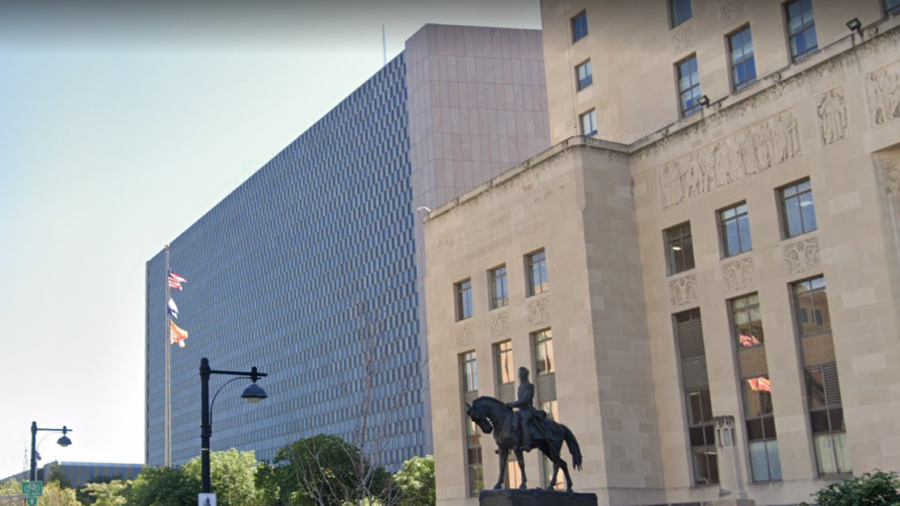Officials in Jackson County, Missouri are seeking a new referendum to remove a pair of statues of the county’s namesake, former President Andrew Jackson.
During the November 2020 election, Jackson County put the issue of whether or not to remove the statues of the former president to a ballot. About 72 percent of voters rejected the proposal, while about 28 percent favored their removal.
On Monday, the county Legislature voted 7–1 on a resolution to remove the pair of statues of Jackson that are in place outside the historic Harry S. Truman Office and Courtroom in Independence, Missouri and another outside the Jackson County Courthouse in Kansas City. The resolution calls for replacing the statues of Jackson with new statues of former President Harry Truman.
A summary (pdf) of the new resolution, introduced by county Legislator Manuel Abarca, states that the county is seeking to remove the statues of Jackson owing to his alleged connection to “genocidal campaigns against indigenous groups or slavery.”
As president, Jackson passed the Indian Removal Act of 1830, which displaced Native American tribes in the eastern United States. Historians estimate several thousand Native Americans died over the course of those forced relocation programs, including an estimated 4,000 members of the Cherokee people. Jackson also endorsed the practice of slavery and, according to his Hermitage estate, the Jackson family owned more than 300 men, women, and children.
After Mr. Abarca introduced his resolution to have the statues of Jackson removed, the county legislators voted to adopt an amended version of the resolution stating the county intends to put the statue removal issue to a vote once more on the November 2024 ballot. It remains unclear when the actual language for the ballot question will be adopted.
Statue Removals Fuel Debate About History
The issue of whether to remove monuments of controversial historical figures has fueled public debates in recent years.
Jackson County’s 2020 proposal to remove statues of Jackson came about amid nationwide protests and riots after George Floyd, a black man, died in Minneapolis police custody. The demonstrations sparked by Mr. Floyd’s death gave rise to a broader debate over America’s history of race relations. Some of that focus turned toward statues of controversial figures and, while some localities handled their statue removals through a formal process, some rioters took the issue into their own hands on numerous occasions, toppling and defacing monuments.
Jackson County Executive Frank White, one of the proponents of the 2020 measure to remove the statues of Jackson, said he remained committed to the idea even after voters rejected the proposal.
“I am proud to have stood up and stood on behalf of a movement demanding fairness, justice and equality in Jackson County,” Mr. White wrote on Twitter on Nov. 4, 2020. “I remain committed in my belief that the statues of a man who owned slaves, caused thousands of Native Americans to die and never stepped foot in our County should be removed from our public facilities.”
While the initial effort to remove the statues of Jackson failed, Jackson County has installed new plaques on those statues, meant to acknowledge the former president’s involvement in slavery and the displacement of Native Americans.
The debates over statues and monuments have touched on a variety of other historical figures, not all of whom were staunch proponents of slavery.
In the summer of 2020, a statue of President Ulysses S. Grant was toppled. Grant had owned a slave for a brief period in his life but freed that man by 1859 and went on to lead Union forces against the slave-owning Confederate states during the Civil War.
In 2020, rioters in Portland, Oregon, toppled a statue of 16th President Abraham Lincoln. Lincoln had owned no slaves and had signed the Emancipation Proclamation, which declared slaves in the Confederate states to be free. Lincoln also advocated for and saw several states ratify the 13th Amendment, which abolished slavery, prior to his assassination.
In June 2020, a group of protesters defended a statue of 26th President Theodore Roosevelt against a removal effort. The statue, which stood in front of the American Museum of Natural History, featured Roosevelt on a horse flanked on one side by a Native American and on the other side by an African man. The American Museum of Natural History said the statue “communicates a racial hierarchy that the Museum and members of the public have long found disturbing.” The statue was eventually removed from the museum’s front and relocated to North Dakota.
NTD News reached out to Mr. Abarca about his proposal to replace the statues of Jackson with new monuments to Truman. Truman was president during the first and only two cases in which atomic weapons were used in wartime—the U.S. bombing of Hiroshima and Nagasaki in Japan—an event that historians estimate led to the deaths of more than 200,000 people, many of whom were civilians.
Mr. Abarca did not respond to the request for comment.

